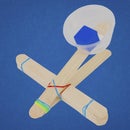Introduction: Pyramid Catapult
This project is born from the idea of making a mini catapult that doesn't require any glue, but is just as sturdy and high-performing as other designs.
You can find the lesson plan, 1-page project sheet, and more project ideas at STEM-Inventions.com
Step 1: Materials
The Engineering Creation Kit has everything you need for this project and many more from STEM Inventions.
3 milkshake straws (2.5 cut into quarters)
When you make a purchase through these links, I may earn an affiliate commission at zero cost to you.
Step 2: Pyramid Frame
Cut 2.5 milkshake straws into quarters. Pinch the straw piece and insert a craft stick. Repeat until there are 3 straw pieces and 3 sticks connected end-to-end.
Fold the shape into a triangle and connect the ends together.
Peel off a length of tape from the roll without severing it. Wrap the entire perimeter triangle in tape as you peel it off of the roll.
Repeat 2 more times to create a total of three triangles. Arrange them in a trapezoid pattern and tape the edges together in at least two places.
Fold the outer two triangles upwards to form the pyramid. Tape the edge together to keep the pyramid shape intact.
Step 3: Catapult Arm
Lay 5 skewers flat and neatly lined up. Keeping the skewers flat, wrap tape around the skewers in at least two places. Tape a craft stick to the center of the skewer bundle to reinforce it.
Insert the pointed end of the three middle skewers into the remaining 1/2 straw piece. Tape it on.
Lay the skewer bundle inside the catapult and align the straw with the front of the pyramid. Tape the straw to the front edge of the pyramid. This will create a flexible joint which will allow the catapult arm to move up and down.
Attaching the arm to the catapult frame requires a lot of dexterity. Encourage your students to take turns helping each other with this step: one person holds the pieces in place while the other tapes it.
Step 4: Rubberband
Loop a rubberband around the catapult arm, then pull it through the pyramid frame. Stretch the rubberband and pull it over the catapult arm again.
Step 5: Attach the Cup
Place a piece of tape at a perpendicular angle on the back of the catapult arm. Hold a cup near the top of the arm and wrap the ends of the tape to the sides of the cup. Be sure to leave some of the skewers exposed at the top of the catapult arm. Use more tape to secure the cup to the catapult arm.
Step 6: Fire!
Place one hand inside the pyramid frame and firmly press on it. Use the fingertips on the other hand to press down on the end of the catapult arm. Pull back, then release by allowing your fingertips to slide off of the skewers.
Step 7: Advanced Ideas: Collapsible Catapult
Click on the images to read the design notes.
Step 8: Safety, Tips, and Troubleshooting
- If students are having trouble launching their catapult, be sure that they have a little bit of skewer exposed at the top of the arm and that they are launching according to the technique displayed in step 6. It is difficult to launch by grasping the cup or pushing on the middle of the catapult arm.
- Some students may have difficulty forming the pyramid shape. Encourage students to work together: one person holds the shape in place while another person tapes it together.
- Attaching the rubber band can be tricky for some students. You may offer to do this part yourself.
- If the catapult arm is wobbly, check to make sure that the end is securely taped to the bottom front of the catapult
- If the cup is wobbly, encourage the student to apply more tape around all sides and around the catapult arm.













